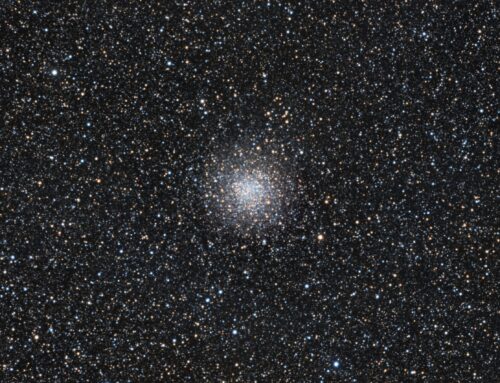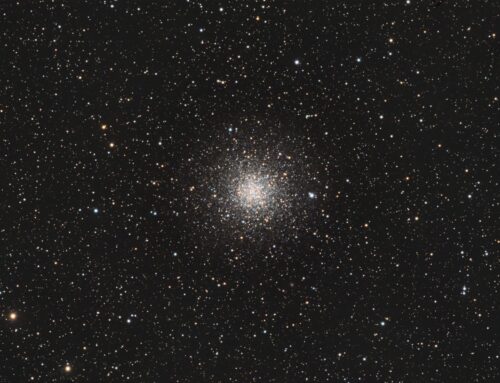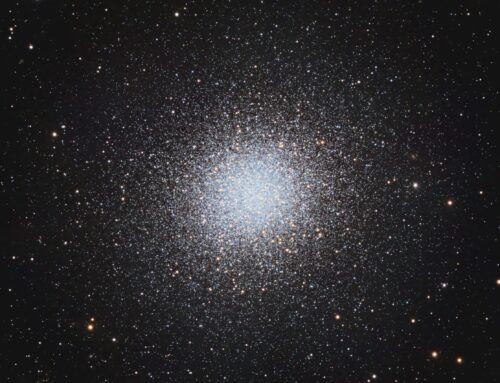M72, Globular Cluster
 Click image for full size version
Click image for full size version
August 13, 2016
M72 is a globular cluster in Aquarius. It’s not the splashiest object of this type, often being overlooked for nearby M2 and M22. In fact, it’s interesting to compare M72 and M22. They are quite different when you look at them side by side at the same image scale.
And the numbers bear out the visual impression: M72 is about 40 times fainter (at magnitude 9.5), 5 times further away (at 55,000 light years), and about 1/5 the visual size (at a little more than 1/3 the moon’s width) compared to M22. And M72 has only about about 168,000 stars compared to almost 300,000 in M22. M72 is 9.5 billion years old, a relative youngster compared to M22, which is 12 billion years old.
Tekkies:
SBIG STL-11000M camera, Baader Ha, R, G and B filters, 10″ f/6.8 ASA astrograph, Paramount MX. Guided with QHY5 guide camera and 80 mm f/6 Stellar-Vue refractor. Acquisition, guiding and mount control with TheSkyX. Focusing with FocusMax. Automation with CCDCommander. All preprocessing and post-processing in PixInsight. Shot from my SkyShed in Guelph, Ontario. No moonlight. Good to excellent transparency and seeing for acquisition of Luminance. Poor to average transparency and seeing for acquisition of R, G and B.
6x10m R, G, B and L unbinned frames (total=4hr).
RGB
Creation and cleanup: L, R, G and B masters were cropped and processed with DBE. The RGB channels were combined and ColorCalibration was applied.
Linear Noise Reduction: MultiscaleLinearTransform was used to reduce noise in the background areas. Layer settings for threshold and strength: Layer 1: 3.0, 0.5 Layer 2: 2.0, 0.35 Layer 3: 1.0, 0.2 Layer 4: 0.5, 0.1
Stretching: HistogramTransformation was applied to make a pleasing yet bright image.
Luminance:
Note – No SynthL was made since the R, G and B data were collected in very poor seeing and degraded the resolution of the luminance.
Deconvolution: A copy of the Luminance (L) image was stretched to use as a deconvolution mask. A star mask was made from unstretched SynthL to use as a local deringing support. Deconvolution was applied (80 iterations, regularized Richardson-Lucy, external PSF made using DynamicPSF tool with about 20 stars; local deringing at 70% and global dark deringing at 0.03).
Linear Noise Reduction: MultiscaleLinearTransform was applied to reduce the noise. Layer settings for threshold and strength: Layer 1: 3.0, 0.5 Layer 2: 2.0, 0.35 Layer 3: 1.0, 0.2 Layer 4: 0.5, 0.1
Stretching: HistogramTransformation was applied to make a pleasing yet bright image. TGVDenoise was applied and the image was re-stretched to reset the black point.
Combining L with RGB:
The luminance channel of the RGB image was extracted, processed and then added back into the RGB image as follows:
1. Extract luminance from the RGB image.
2. Apply LinearFit using L as the reference.
3. Use ChannelCombination in Lab mode to replace the RGB’s luminance with the fitted luminance from step 2.
4. LRGBCombine was then used to make an LRGB image.
Final Processing of LRGB:
Background, stars and cluster brightness, contrast and saturation were adjusted in several iterations using Curves with masks as required.
Image scale is about 1.1 arcsec per pixel for this camera / telescope combination.







Leave A Comment